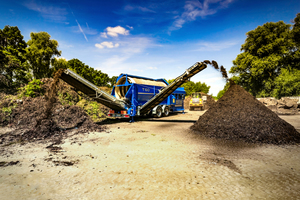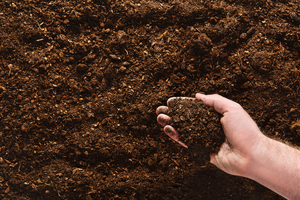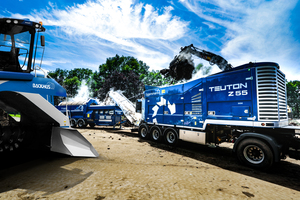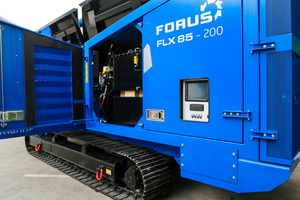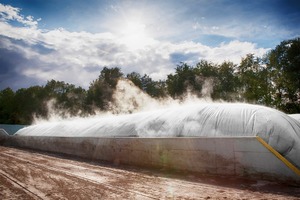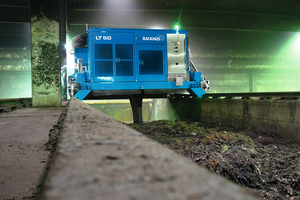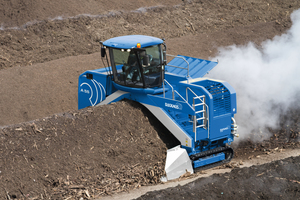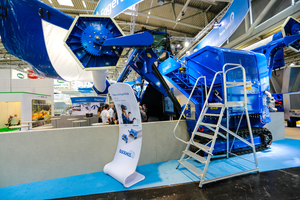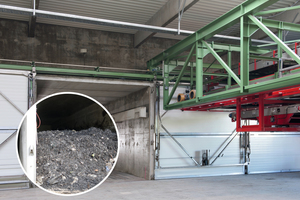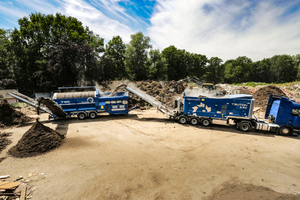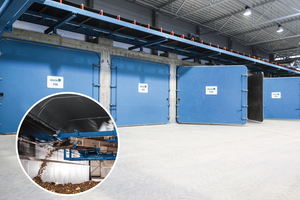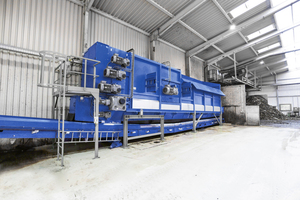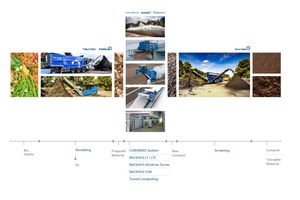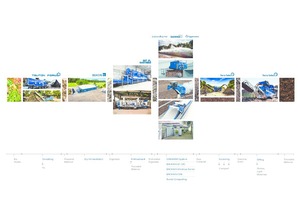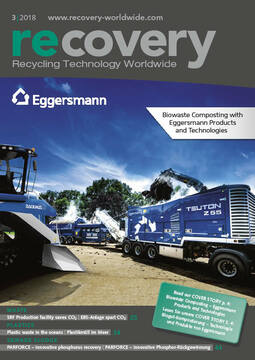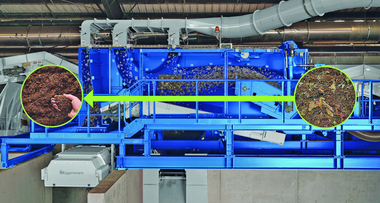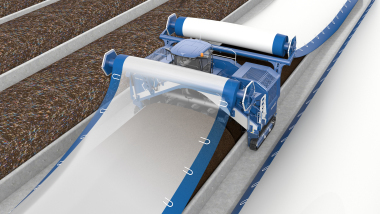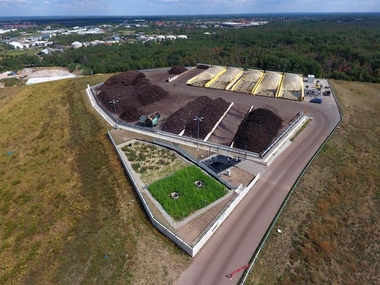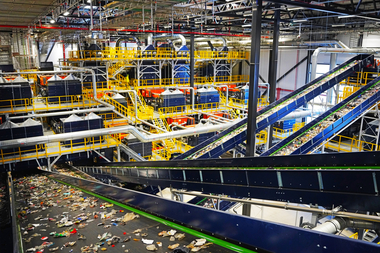Eggersmann Products and Technologies
Resource-efficient recycling management forms the basis for responsible and environmentally friendly action and has become an integral part of German and European legislation. In particular, the preservation of humus-rich and productive agricultural land or its improvement is playing an increasingly important role, not only in view of global population growth and increasing demands on food production. The biowaste fraction in the waste streams is thus becoming increasingly important as a ”renewable“ resource.
After biological treatment and preparation, the organic substance and the valuable nutrients contained can be returned to the cycle in an advantageous and targeted manner in the form of organic fertilisers. Contrary to resource-limiting or energy-intensive mineral fertilisers, the use of quality compost in the long run yields a noticeable improvement in humus content and promotes healthy and diverse soil life. Furthermore, greenhouse gas emissions (methane) are significantly reduced by proper composting of organic waste as opposed to simple or uncontrolled land filling as is still largely practised in developing and emerging countries. Moreover, using a fermentation system upstream from the composting process, one can ideally turn biowaste into regenerative energy in the form of biogas and electricity.
The Eggersmann Group is one of the leading plant and special machine suppliers for the waste management industry and possesses decades of experience in the field of mechanical and biological (aerobic and anaerobic) waste treatment methods and processes such as fermentation, composting and biological drying. Eggersmann’s expertise ranges from the planning and construction to the operation of waste treatment systems.
Generally speaking, organic resources can be returned to the natural cycle in two ways: Through the composting of fresh biowaste or the aerobic post-treatment of digestate from an upstream fermentation system. Both procedures have their justification. Eggersmann supplies the entire equipment and full know-how for both approaches.
Both process lines usually start with the shredding of the batches of biowaste that are being delivered. During treatment, its conversion into disintegrated grain sizes, which serve the composting process, and the separation of impurities are decisive. Compact, slow-speed shredders can best meet these requirements. For instance, Eggersmann’s TEUTON Single-Shaft Universal Shredder – with its patented 19-teeth counter-blade construction – returns an end product ready for composting. Various adjustable parameters furthermore allow for maximum flexibility: Without the use of tools, the gap between the roller fitted with 30 exchangeable shredding tools and the counter-blade can be adjusted via ten different steps. The cutting gap can be varied depending on the desired final grain size in the material discharge up to a maximum of approx. 100 mm. Further adjustments to the final grain size can be made effortlessly by changing the shredding tool on the roller or by using a solid screen basket system (80 – 250 mm) which can be exchanged without the use of tools. This makes it possible, for instance, to produce biomass in a single work step, i.e. the TEUTON takes care of pre- and post-shredding in a single work cycle. Moreover, the TEUTON excels with a robust steel construction that withstands even the highest levels of stress and thus guarantees a continuous shredding process as well as an even delivery of the shredded material to the downstream conveying systems and/or the subsequent process stages. The TEUTON is available as a stationary and mobile version with wheels as well as a track version.
Under the brand name FORUS, the Eggersmann Group focusses exclusively on the development and further development of slow-speed two shaft shredders. With its brand-new FORUS FLX 85 model, Eggersmann introduces to the market the first shredder that can be converted from conventional synchronous shredding to asynchronous shredding in just a few simple steps. Its swing-hinged hopper walls and a platform built into the doors of the drive unit furthermore allow for comfortable access to the shredding shafts. These can be exchanged quickly and safely by means of a threaded flange coupling which means the machine can be effortlessly adjusted to various materials such as biowaste, garden waste, waste wood and more. In addition, the type of shredding and the grain size of the shredded material can be adjusted through one’s choice of tools. In addition, a press-feed unit in the feed hopper prevents the bridging of light and bulky materials and thus ensures optimised throughput.
When leaving the shredder, the shredded material should not exceed a defined grain size of 100 – 120 mm. As a rule, the material is being highly frayed during shredding and numerous freshly broken up surfaces are created, which can then be optimally populated by the micro-organisms.
After shredding, various processes are available for composting the biowaste. These can be divided into different categories: open, quasi closed and closed processes and, according to the decomposed material’s movement, into dynamic and static systems.
The static, quasi closed CONVAERO system is a membrane-covered system for the composting or biological drying of materials with organic content that excels with high efficiency, flexibility and user-friendliness as well as controlled treatment times. The optimum process conditions for the degradation of native organic waste components by micro-organisms are established by the specially designed membrane cover and the aeration setup consisting of the aeration base and the ventilation technology, which is optimised in terms of temperature, pressure and time. During composting, the waste is sanitised at 60 – 80°C. The setup parameters are selected in such a way that sufficient atmospheric oxygen is available for a continuously aerobic, stable process, while at the same time minimising energy costs.
Another possibility for composting biowaste and biological drying of organic rich fractions from waste streams are the BACKHUS brand Lane Turner systems LT and LTC (Lane Turner Closed). Lane composting with the BACKHUS LT ranks among the open, dynamic methods since, during the process, the decomposing material is being moved and mixed mechanically several times and statically rests in between. The BACKHUS LTC is a perfect example for closed, dynamic lane composting with forced ventilation of the decomposing material. The compost is turned by the fully automated BACKHUS Turners LT or LTC that run on the lane walls. In the process, the BACKHUS Turners constantly provide loose filling, irrigation and aeration or allow for the material’s aeration and thus enable the maximum decomposition of biologically, aerobically degradable organic dry substance resulting in a compost suitable for fine treatment.
Windrow composting is an open method that is preferred by operators of garden waste composting plants or for purposes of post-decomposition in the field of biowaste composting because of its low costs and simple operation. In this type of composting, the chimney draft effect is used, which is specifically linked to the shape of the windrow. The hot air inside the windrow rises to the top of the windrow. The draft effect sucks fresh air into the windrow’s base. This creates a natural fresh air flow through the windrow, which in conjunction with the favourable ratio of windrow surface to windrow volume ensures excellent self-aeration. The BACKHUS A Series Turners’ regular turning of the windrows mixes and homogenises the material. This enables a permanently loose windrow structure and thus secures the air void volume in the material, dissolves settlement effects and guarantees a homogeneous flow all the way to the core zones. The resulting optimised decomposition of the compost material leads to significantly shorter treatment times.
With the BACKHUS CON Series, Eggersmann introduces a combination between the flexible CONVAERO system and the proven BACKHUS technology. The turning of a membrane-covered lane with the BACKHUS CON, a turner with built-in membrane winder, is a quasi closed system. Membrane pick-up, repositioning, remoistening (optional) and covering are carried out simultaneously in one work cycle. This results in a short process time, low space requirements and minimal operating costs. Even materials with a higher water content can be composted or dried with a relatively low proportion of structural material. Apart from processing membrane-covered lanes with lateral walls, the BACKHUS CON Series is also designed to process windrows.
Tunnel composting is the most common process of aerobic treatment. This is a closed system with self-contained process rooms, i.e. the entire process takes place within a completely enclosed hall. All exhaust air flows are captured entirely. Composting in tunnels is also referred to as a static system with dynamic phases, which are generated by freely selectable turning processes. The process is furthermore characterised by optimal and flexible adaptability to the respective task. This is caused both by the recirculation of air and by the incorporation of external heat.
The use of screening and separation technology is required for the fine treatment or packaging of the matured raw compost. Under the Terra Select brand, which specialises in screening and separation technology, Eggersmann offers a wide range of biomass treatment machines. The Terra Select S 60 Star Screen, for instance, was developed for high throughput and is capable of separating both the fines content of, for instance, < 10 mm and the oversize grain of > 150 mm in a single work cycle. The result is a marketable compost product, separated impurities and a middle fraction that can be returned to the cycle.
Instead of star screening technology, one can also use the Terra Select Double Trommel Screening technology – with it, one can produce three fractions in a single work cycle. The Terra Select DT 60 Double Trommel Screen is suitable for a throughput of up to 120 m³/h and achieves fines and oversize grain separation in a single work step.
Alternatively, Terra Select offers two fraction trommel screens such as the proven Terra Select T 60 or the brand-new Terra Select T 55. Like the other models, these are characterised by clever detail solutions, service-friendliness and durability. The fine fraction obtained in this type of screening is a marketable compost product.
The resulting screen overflow (screen residue) can usually be reused as a structural material for composting. In the context of the packaging of finished products or the preparation of screen overflows as structural material, it is also possible to use Terra Select Windsifters to reduce contamination with light materials (foil particles) or heavy materials (stones).
As already mentioned, not only fresh organic material can be composted; composting of digestate from an upstream fermentation process is also possible. Shredding also comes before fermentation at the top of the process chain.
The digested material is then introduced into the fermentation process. BEKON, a member of the Eggersmann Group, offers the optimum solution for every input material. The percolation process, in which the waste is inoculated through increased percolation rates, is particularly suitable for highly structured waste and waste with good aeration properties. In the percolation process, the temperature is controlled by means of an aerobic starting phase and underfloor heating integrated into the concrete. The digestate process is more suitable for waste with higher water contents and/or little structure. In the digestate process, the temperature is controlled by the underfloor and wall heating integrated into the concrete. The inoculation takes place by returning approx. 40 % digestate. Thanks to digestate return, the process can be run at minimised percolation rates. The space requirement is the same for both methods, depending on the boundary conditions.
In general, both processes produce digestate with very good structural properties and comparatively low water content, which is very well suited for aerobic composting and further treatment into compost/fertiliser.
However, the digestate varies depending on the quality of the input material and the fermentation process used, so that the conditions for the subsequent composting process may not or only to a limited extent be met without appropriate pre-treatment.
The BRT HARTNER DM Digestate Mixer is an aggregate that is used upstream from the composting unit for the optimal production of mixes from digestate and structuring materials such as garden waste, raw compost or screen overflow. The system of mixing the substrates with the aid of mixing rollers in the dynamic material flow effectively prevents compaction or kneading effects and loosens up and homogenises the substrate.
Excessive water content in the digestate leads to problems when processing it further into compost. The BRT HARTNER DCD Digestate Conditioner/Dryer can help. To perfectly pretreat digestate mixtures before the aerobic treatment of the material, the input substrates are mixed into the dynamic material flow, then homogenised and loosened up. The pressure ventilation of the material with pre-heated air, optionally with circulating air, and active floor heating of the closed machine are the basis for an optimised ammoniac and water discharge through the exhaust air. This exhaust air is processed by the exhaust air treatment system. The production of the mixture and treatment of the substrates in the digestate conditioner return an optimum substrate for composting. Alternatively, the unit can also be used for thermal drying of a wide variety of materials.

